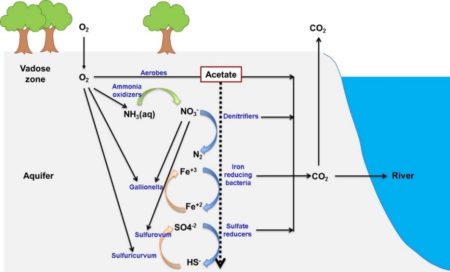
Schematic representation of the genome-informed geochemical reaction network included in model simulations.
Scientific Achievement
We use a genome-informed reactive transport modeling approach to analyze the cumulative impact of naturally reduced zones, water table fluctuations, and temperature gradients on subsurface carbon fluxes within a floodplain environment.
Significance and Impact
- Model simulations considering only abiotic reactions underestimated atmospheric CO2 fluxes by up to 230% compared to simulations with genome-informed biotic pathways.
- Ignoring annual water table fluctuations in model simulations led to an overestimation of groundwater carbon exports from the Rifle floodplain, while ignoring annual temperature gradient variations underestimated carbon exports by almost 150%.
Research Details
- 2-D coupled variably-saturated, non-isothermal flow and biogeochemical reactive transport modeling was applied to improve our understanding of the abiotic and microbially mediated reactions controlling carbon dynamics at the Rifle floodplain site.
- This study indicates that spatial microbial and redox zonation as well as temporal fluctuations of temperature and water table depth contribute significantly to subsurface carbon fluxes in floodplains and need to be represented appropriately in model simulations.
Citation
Arora, B., Spycher, N.F., Steefel, C.I., Molins, S., Bill, M., Conrad, M.E., Dong, W., Faybishenko, B., Tokunaga, T.K., Wan, J. and Williams, K.H., 2016. Influence of hydrological, biogeochemical and temperature transients on subsurface carbon fluxes in a flood plain environment. Biogeochemistry, 127(2-3), pp.367-396. DOI: 10.1007/s10533-016-0186-8
